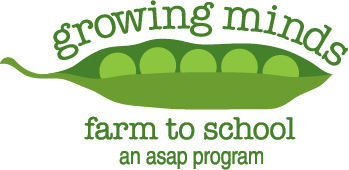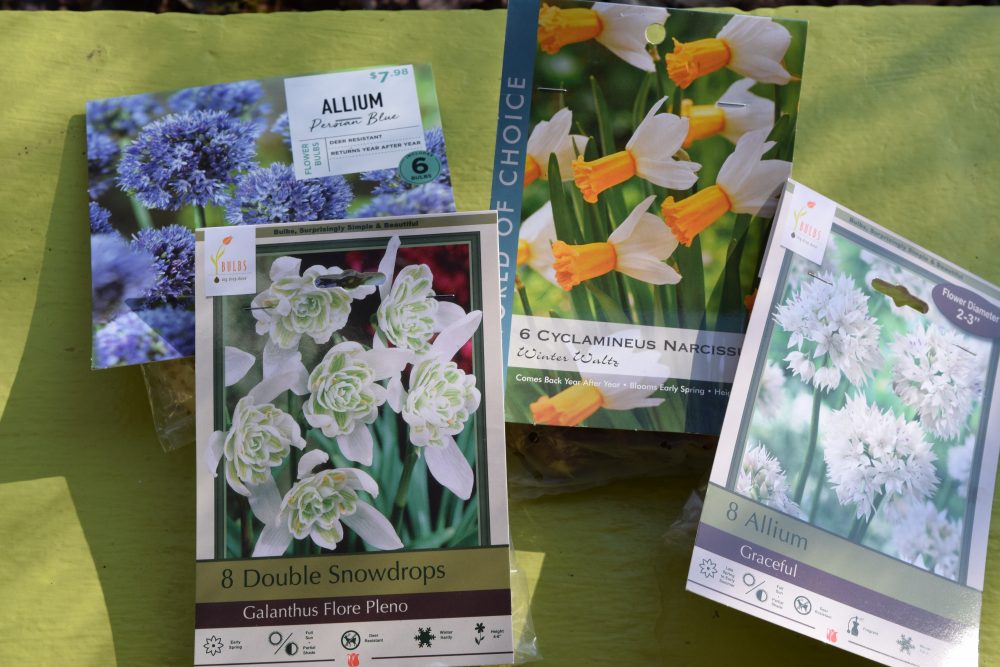This week’s theme is bulbs. Our “Growing Minds Day by Day” educational resource lists are designed for families and educators.
Growing Minds Day by Day
Bulbs
“Bulb” is a term we use to refer to plants with underground, fleshy structures used to store food reserves when water and nutrients are less available. There are many different types of bulbs, including spring-blooming tulip, daffodil, iris, and crocus flowers, and common vegetables, like garlic, onions, shallots, chives, scallions, and leeks. These onion-like veggies are members of the allium plant family. Early November is a great time to plant bulbs in the garden. These hearty crops will grow through the winter, giving kids some growth to track in the garden throughout the cold months. Edible bulbs will provide tasty additions to your meals next spring and summer. You can purchase bulbs at a local garden supply store or hardware store.
Books:
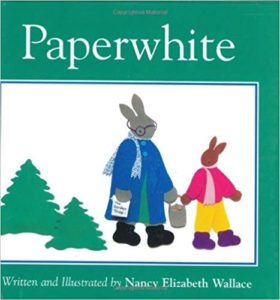 Paperwhite
Paperwhite
Watch as Lucy and Miss Mamie bring a little spring into Mamie’s house during the cold winter months. Together they grow a paperwhite bulb. This story by Nancy Wallace celebrates the wonders of nature as well as inter-generational friendship. Watch a read aloud on YouTube. Recommended for ages 5-6.
 Ode to an Onion: Pablo Neruda & His Muse
Ode to an Onion: Pablo Neruda & His Muse
A poetic, beautifully illustrated book by Alexandria Giardino, inspired by Ode to the Onion by Chilean poet Pablo Neruda (1904–1973). Pablo has a lunch date with his friend Matilde, who shows the moody poet her garden. Where Pablo sees conflict and sadness, Matilde sees love and hope. The story is a simple ode to a vegetable that is humble and luminous, dark and light, gloomy and glad, full of grief and full of joy—just like life. Watch a read aloud on YouTube. Recommended for ages 4-8.
Find more books
Both of the books above are available for Asheville-based educators to check out from our lending library. Visit the Growing Minds’ farm to school literature database to discover more of our favorite fall-themed children’s books.
Local Food Recipe:
The sauce for this pasta features two edible bulbs, onion and garlic. The recipe comes from the owners of Cúrate, a restaurant specializing in Spanish cuisine in Asheville.
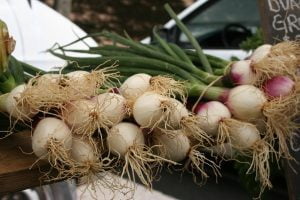 Pasta with Fresh Garlic and Basil Tomato Sauce
Pasta with Fresh Garlic and Basil Tomato Sauce
Recipe by Liz and Katie Button of Cúrate
Ingredients:
- 3 tablespoons extra virgin olive oil
- 1 medium local onion, minced
- 2 medium local garlic cloves, minced or pressed with garlic press
- 2 pounds fresh tomatoes, cored, peeled, seeded, and cut into 1/2 inch pieces (or substitute 1 28-oz. can of whole peeled tomatoes)
- 2 tablespoons chopped fresh basil leaves
- Salt, pepper, and a pinch of sugar to taste
- 1 pound of pasta
- Parmesan cheese to grate on top
Directions:
- Heat 2 tablespoons oil and minced onion in a medium skillet over medium heat until the onion is soft and translucent, add garlic and cook until it is fragrant but not browned, about 2 minutes.
- Stir in tomatoes; increase heat to medium high heat and cook until liquid given off by tomatoes evaporates and tomato pieces lose their shape to form a chunky sauce, about 10 minutes.
- Stir in basil and add salt, pepper, and a little pinch of sugar to taste.
- Meanwhile bring water to boil, salt the water, and cook until pasta is al dente.
- Reserve 1/4 cup pasta cooking water; drain pasta and transfer back to the cooking pot.
- Mix in reserved cooking water, sauce, and remaining tablespoon of oil; toss well to combine.
- Serve immediately.
Educational Resources:
A fall bulb planting activity could be paired with one or more of the lesson plans below to teach about plant parts, soil, or changing seasons.
Growing Minds Lesson Plans
- Roots and Shoots (preschool): Teach students about how vegetables grow and guide them in tasting veggies that grow below ground and above ground.
- Root Exploration (K-2): Introduce students to roots and the ways they function. Talk with students about the 5 “Ws” (who, what, when, where, and why) and teach them as a guide for creating a poem.
- Soil Exploration (K-2): Through garden exploration, students will learn about the properties of soil and why soil is important to plants. They will closely observe soil and practice tallying and reporting results of soil experiments.
- Soil Temperature (K-2): Students will use thermometers to measure soil temperature and use the information to determine if the soil is warm enough to support plant growth.
- Changing Leaves and Changing Seasons (K-2): Teach students about changing seasons and the season of autumn. Students create a leaf spinner and record daily temperatures.
- Seasons on a Farm (K-2): Students will learn about seasonal weather patterns and their effects on local farms and gardens and use qualitative and quantitative measurements to describe weather.
Activities:
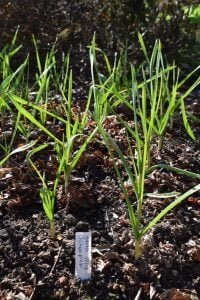 Plant Garlic in the Garden
Plant Garlic in the Garden
Don’t let the cool weather fool you, there is still time to get some garlic planted in the garden this fall! Never grown garlic before? Here’s how to do it:
- Break a garlic bulb apart into individual cloves, being careful to keep the papery skins covering each clove intact.
- When planting garlic cloves, you want to put them in the ground with the flat end down and the pointed end up.
- Plant the garlic cloves 4-6 inches apart, 2 inches down in the soil, with 12-15 inches between rows. Mulch the beds after planting with straw or shredded leaves.
- After a few weeks, you will begin to see green shoots emerge. This is your garlic plant!
- Water occasionally, especially in the spring. Stop watering when the garlic leaves begin to turn yellow (late June and into early July).
- Harvest bulbs when there are 4 to 5 green leaves still on the plant. You will want to gently dig up the bulb and leave the stalks attached.
- After harvesting, hang the garlic to dry out for a few weeks before removing the stalks and enjoying!
Grow bulbs indoors: Collect clear cups or glass containers. Fill each cup about 3/4 full with rocks or marbles. Place the bulb on the surface, gently pressing it into the rocks. Fill the cup with water until it barely covers the bottom of the bulb. Place the bulbs in a sunny window. Continue observing the bulbs each day and watch what happens. Be sure to add water to the container as the water level begins to go down. Some favorite flower bulbs to grow indoors in the winter include amaryllis, paperwhites, and hyacinths, but just about any bulb can be grown this way.
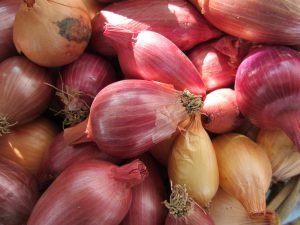 Bulb Exploration: Examine two or three different types of bulbs closely with your child (if you don’t have flower bulbs, you can examine onions, shallots, or garlic). How are they similar? How are they different? What do they imagine will grow from the bulb? Will it have a flower? What color will the flower be? Will it have large or small blooms? Have your child draw a picture of what they imagine the bulb will look like in the spring, or write down their predictions. Refer back to their predictions in the spring when the bulb emerges and blooms. Cut one of the bulbs in half and examine the interior structure. Use this Bulb Basics guide from University of Illinois Extension to identify different parts of the bulb. Plant any remaining bulbs in the garden according to the package instructions. Be sure to mark their place with a sign or rock so you don’t forget where they were planted!
Bulb Exploration: Examine two or three different types of bulbs closely with your child (if you don’t have flower bulbs, you can examine onions, shallots, or garlic). How are they similar? How are they different? What do they imagine will grow from the bulb? Will it have a flower? What color will the flower be? Will it have large or small blooms? Have your child draw a picture of what they imagine the bulb will look like in the spring, or write down their predictions. Refer back to their predictions in the spring when the bulb emerges and blooms. Cut one of the bulbs in half and examine the interior structure. Use this Bulb Basics guide from University of Illinois Extension to identify different parts of the bulb. Plant any remaining bulbs in the garden according to the package instructions. Be sure to mark their place with a sign or rock so you don’t forget where they were planted!
Onion Skin Dye: Did you know that the papery, outer skins of onions can be saved and used to create natural dyes for fabric or yarn? Onion skins have been used to make dyes for thousands of years. Find out how to experiment with your own natural dye here.
Farm to Preschool Toolkit:
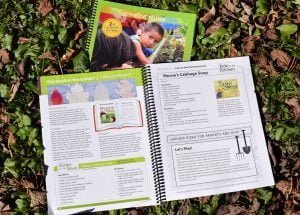 Looking for more farm to preschool activities and ideas to keep your class engaged through the winter months? We’re excited to share that the Growing Minds Farm to Preschool Toolkit has been updated and is back in stock! This second edition is updated with a new, easy to use format and simple, streamlined local food recipes for the classroom and home. It contains all of our farm to preschool resources, including lesson plans, “This Week in the Garden” activity guides, “Farm to School Goes Home” parent handouts, local food sourcing guidance, and tips for cooking and gardening with young children. The Toolkit is available as a hard copy, digital flip book, or free digital download here.
Looking for more farm to preschool activities and ideas to keep your class engaged through the winter months? We’re excited to share that the Growing Minds Farm to Preschool Toolkit has been updated and is back in stock! This second edition is updated with a new, easy to use format and simple, streamlined local food recipes for the classroom and home. It contains all of our farm to preschool resources, including lesson plans, “This Week in the Garden” activity guides, “Farm to School Goes Home” parent handouts, local food sourcing guidance, and tips for cooking and gardening with young children. The Toolkit is available as a hard copy, digital flip book, or free digital download here.
—
That’s it for this week. Check back next week for new resources. Click here to access Day by Day resources from past weeks. If you didn’t find what you’re looking for here, please visit our Lesson Plans page.
